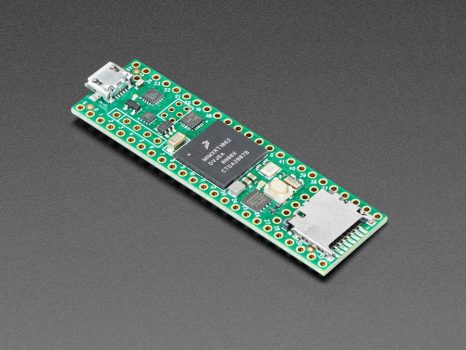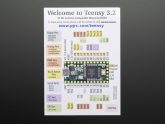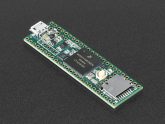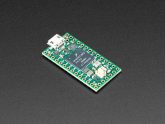PJRC Teensy 4.1 Development Board
PJRC Teensy 4.1 Development Board
-
The Teensy 4.1, like the 4.0, also features an ARM Cortex-M7 processor at 600 MHz, with an NXP iMXRT1062 chip, the fastest microcontroller available today - ten times faster than the Teensy 3.2! The NXP iMXRT1062 is a 'cross-over' processor, which has the functionality of a microcontroller, at the speeds of a microcomputer. It's perfect for when you need tons of flash, RAM and, to crunch lots of data, or when you need two full-speed USB ports.
Teensy 4.1 comes with four times larger flash memory than the 4.0, and two new locations to optionally add more memory. The Teensy 4.1 has the same form factor as the Teensy 3.6 (2.4" by 0.7"), but provides a ton more I/O capability, including an 100MB Ethernet PHY, SD card socket (SDIO connected), and USB host port. Please check out the Teensy 4.0 page for common specifications and features.
Memory
The bottom side of Teensy 4.1 has locations to solder 2 memory chips. The smaller location is meant for a PSRAM SOIC-8 chip which we stock. The larger location is intended for QSPI flash memory.
USB Host
Teensy 4.1's USB Host port allows you to connect USB devices, like keyboards and MIDI musical instruments. A 5 pin header and a USB Host cable are needed to be able to plug in a USB device. You can also use one of these cables to connect to the USB pins
Power Consumption & Management
When running at 600 MHz, the Teensy 4.1 consumes approximately 100mA current and provides support for dynamic clock scaling. Unlike traditional microcontrollers, where changing the clock speed causes wrong baud rates and other issues, Teensy 4.1 hardware and Teensyduino's software support for Arduino timing functions are designed to allow dynamically speed changes. Serial baud rates, audio streaming sample rates, and Arduino functions like delay() and millis(), and Teensyduino's extensions like IntervalTimer and elapsedMillis, continue to work properly while the CPU changes speed. Teensy 4.1 also provides a power shut off feature. By connecting a pushbutton to the On/Off pin, the 3.3V power supply can be completely disabled by holding the button for five seconds, and turned back on by a brief button press. If a coin cell is connected to VBAT, Teensy 4.1's RTC also continues to keep track of date & time while the power is off. Teensy 4.1 also can also be overclocked, well beyond 600MHz!
The ARM Cortex-M7 brings many powerful CPU features to a true real-time microcontroller platform. The Cortex-M7 is a dual-issue superscaler processor, meaning the M7 can execute two instructions per clock cycle, at 600MHz! Of course, executing two simultaneously depends upon the compiler ordering instructions and registers. Initial benchmarks have shown C++ code compiled by Arduino tends to achieve two instructions about 40% to 50% of the time while performing numerically intensive work using integers and pointers. The Cortex-M7 is the first ARM microcontroller to use branch prediction. On M4, loops and other code which much branch take three clock cycles. With M7, after a loop has executed a few times, the branch prediction removes that overhead, allowing the branch instruction to run in only a single clock cycle.
Tightly Coupled Memory is a special feature which allows Cortex-M7 fast single cycle access to memory using a pair of 64 bit wide buses. The ITCM bus provides a 64 bit path to fetch instructions. The DTCM bus is actually a pair of 32 bit paths, allowing M7 to perform up to two separate memory accesses in the same cycle. These extremely high speed buses are separate from M7's main AXI bus, which accesses other memory and peripherals. 512 of memory can be accessed as tightly coupled memory. Teensyduino automatically allocates your Arduino sketch code into ITCM and all non-malloc memory use to the fast DTCM, unless you add extra keywords to override the optimized default. Memory not accessed on the tightly coupled buses is optimized for DMA access by peripherals. Because the bulk of M7's memory access is done on the two tightly coupled buses, powerful DMA-based peripherals have excellent access to the non-TCM memory for highly efficient I/O.
Teensy 4.1's Cortex-M7 processor includes a floating point unit (FPU) which supports both 64 bit "double" and 32 bit "float". With M4's FPU on Teensy 3.5 & 3.6, and also Atmel SAMD51 chips, only 32 bit float is hardware accelerated. Any use of double, double functions like log(), sin(), cos() means slow software implemented math. Teensy 4.1 executes all of these with FPU hardware.
Information, documentation, and specs are on the Teensy site. Please check it out for more details!
Note: Teensy 4.1 does not include headers, a USB cable, or hub.
-
Verzió 4.1Raktárkészlet NINCSCikkszám ADA-4622













